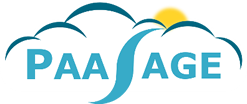D1.6.1-Model Based Cloud Platform Upperware
This document outlines the initial PaaSage architecture at the end of the first year of the project. The deliverable describes the key components that make up the PaaSage platform. It also includes an overview of the project requirements and use cases, using a Storyboard approach to link the use case behaviour with the architectural components. Identification of and expected advancement from the state of the art in the field is also part of this document. Finally we outline steps for year 2.
The architecture will deliver and support the following novel features in PaaSage:
- Advanced modelling language for Clouds, utilising models to characterise users, applications, data and platforms as the common thread through the PaaSage environment;
- Live Cloud model adaptation to ensure application execution in-line with service level agreements (SLA) and key performance indicators (KPI) criteria;
- Model-based support for the porting of legacy applications into the Cloud;
- Cross Platform application execution utilising enhanced PaaSage models;
- Optimised Cross-Cloud model based deployment of applications.
- Support for the development of complex deployments and the migration of local systems to Clouds in a model-based standardised way.
Support for PaaSage features requires the following architectural measures:
- Participation in the design and standardisation of an open, powerful, and expressive modelling language together with the MODAClouds project for Cloud-independent modelling of enterprise systems;
- Provision of an intelligent Integrated Development Environment (IDE) supporting the modelling language and supporting the developer in the task of optimising the application using knowledge from experts and monitoring;
- Creation of mappers and generators that allow a Cloud application modelled with PaaSage to be deployed in a distributed environment, interacting with multiple Cloud providers as required for Cross-Cloud deployments;
- Definition and implementation of metadata relevant for Cloud deployment of applications, alongside mechanisms to acquire the metadata and critical performance indicators from various classes of users, from running applications and to reuse the historical metadata available on the services in the application design and deployment.
The deliverable represents the first steps in the PaaSage architecture toward a blueprint of a platform that will be developed so that it can be used in the following ways:
- Within a commercial or non-commercial organisation to improve the way applications utilise internal and external Cloud platforms;
- Within an open systems development community to improve knowledge of how various applications perform on various (combinations of) Cloud platforms;
- As an individual development environment for individual application developers who develop (for sale or other use) applications that need to be deployable across differing Cloud platforms;
And by the following classes of users:
- Organisational or government policymakers;
- Organisational chief executives;
- Organisational IT directors;
- Systems administrators (including database administrators);
- Application developers or modifiers;
- Business application owners;
This deliverable charts our progress at the end of the first year of the project. The architectural designs and component descriptions are the basis on which the initial software implementation will be built during year 2 of the project. It is expected during this process new requirements and functionality will emerge that will go into an internal updated version of this document at month 24 of the project. The second contracted deliverable (D1.6.2: Final Architecture) is due at Month 48.

